|

|
Wolverhampton's Blue
Plaques
Darlington Street,
Waterloo Road, Church Street & George Street
|
 |
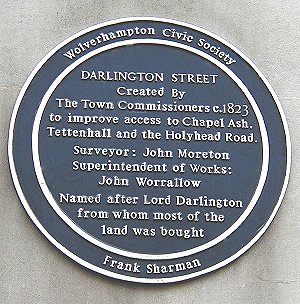 |
Commemorating:
The building of Darlington Street.
Sponsored by:
Frank Sharman
Location:
At the top of Darlington Street, on the side of Beatties
department store.
|
| Darlington Street was constructed on land
belonging to Lord Darlington who sold it to the Town
Commissioners for £350 per acre. It opened in 1823 and was
constructed by John Worrallow, who had the dubious distinction
of being appointed in 1814, to the posts of Borough Engineer,
Chief Constable, Sanitary Inspector, Weights and Measures
Inspector and Clean Air Officer. When they also appointed him as
Markets Manager he went on strike and his annual salary was
raised to £80. Work on the street should have started in 1814,
but was held up until 1821 when the matter of Red Lion Walk
could be resolved. This footpath ran from Salop Street to the
rear of the Red Lion Inn in North Street. |
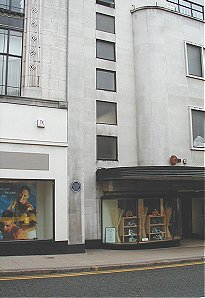 |
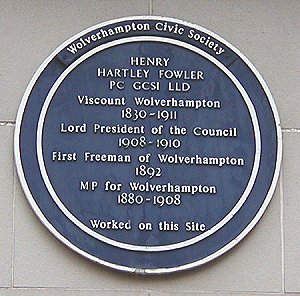 |
Commemorating:
Henry Hartley Fowler who was a Wolverhampton M.P. and Cabinet
Minister.
Sponsored by:
Fowler, Langley & Wright.
Location:
Darlington Street on the side of Dixons Estate Agents, at the
corner of Waterloo Road.
|
| Sir Henry Hartley Fowler
(1830-1911) was a former Mayor of the Borough who became
an MP for the town in 1880. He proposed the Wolverhampton
Corporation Act which was passed in 1891 and in the same year
became the first Freeman of the Borough. In 1894, he was made
Secretary of State for India and was decorated with the order of
the Grand Commander of the Star of India by Queen Victoria.
The photograph shows the plaque on the
side of Dixons Estate Agents. |
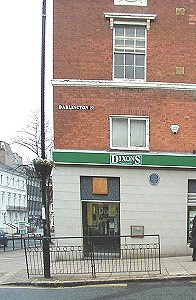 |
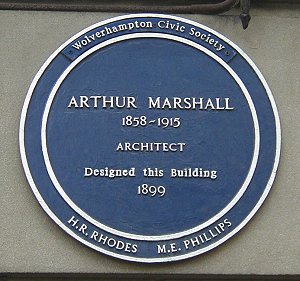 |
Commemorating:
Arthur Marshall who was the architect that designed
Darlington Street Methodist Church.
Sponsored by:
Richard Rhodes & Michael Phillips.
Location:
On the front of Darlington Street Methodist Church. |
| Darlington Street Methodist Church opened on 29th
October 1901. It is capable of seating 1200 people, and is
a replacement for an older church and school built in 1825. The
plaque is mounted on the front wall, just to the left of the
doors. |
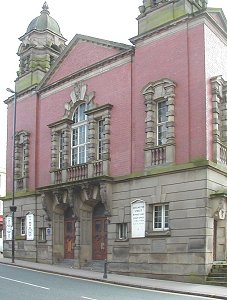 |
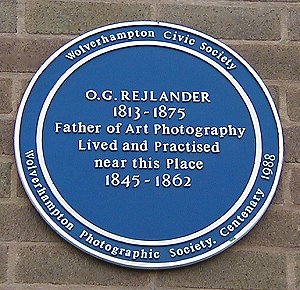 |
Commemorating:
O. G. Rejlander.
Sponsored by:
Wolverhampton Photographic Society.
Location:
Darlington Street roundabout.
|
| The date and place of Rejlander's birth are
uncertain but 1813 and Sweden are the best guesses. He
came to Wolverhampton in 1846, possibly to work as an artist in
the japanning trade. He took up photography about 1851. He
soon attained national fame as an art photographer, producing
genre pictures and tableaux, many of them using local people as
models. His most famous works are, perhaps, Two Ways of
Life (a vast allegorical composition made with multiple
exposures) and poor Jo (a study of a ragged child, despairingly
slumped on a door step, an image still much used in charitable
appeals). He moved to London in 1862.
In this detail from a self portrait, Rejlander is shown as a
Rifle Volunteer. In his Wolverhampton days he was active
in local social life and a keen member of the South Staffs
Yeomanry.

|
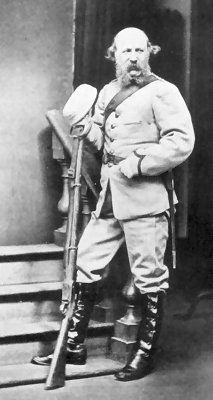 |
| The plaque is mounted on the front of the empty
building that was built as a car showroom by Bradburn & Wedge.
It is situated on the ring road by the side of the Darlington
Street roundabout. |
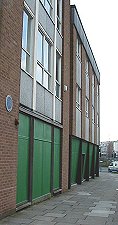 |
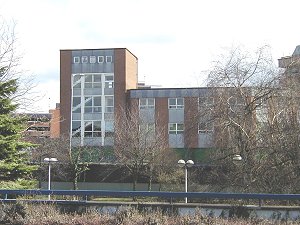 |
 |
Commemorating:
The 4 Macdonald Sisters who married famous men or had famous
sons.
Sponsored by:
Walker, Barnett & Hill.
Location:
Waterloo Road, on the corner of Clarence Street.
|
| The plaque is mounted on the front of Your Move
estate agents. The building was formerly occupied by
Walker, Barnett & Hill. |
 |
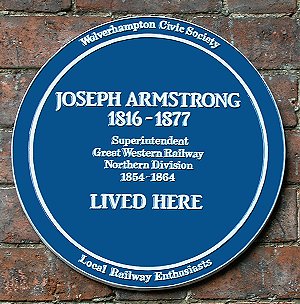 |
Commemorating:
Joseph Armstrong, Locomotive Superintendent at the railway
works.
Sponsored by:
Local railway enthusiasts.
Location:
Waterloo Road, opposite New Hampton Road East.

|
|
The unveiling ceremony on 10th
November, 2004.
Left to right:
Dick Rhodes, Chairman of the
Wolverhampton Civic Society; Rudy Herbert, Civic Society; and
Mervyn Srodzinsky, railway historian, who sponsored the plaque.
|
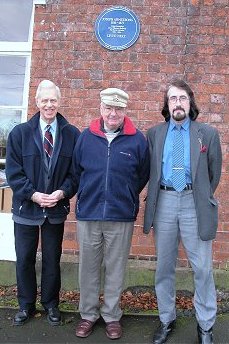 |
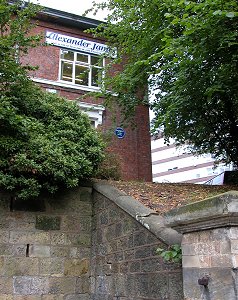 |
Joseph Armstrong obtained the post of Assistant
Locomotive Superintendent of the Shrewsbury & Chester Railway in
1846. Seven years later the railway company merged with the
Shrewsbury & Birmingham Railway, which ran to Wolverhampton.
Joseph was put in charge of the locomotive stock and moved here.
The following year the company became part of the Northern
Division of the Great Western Railway and Joseph became
Locomotive Superintendent. He oversaw the building of the works
and soon set about designing his first locomotives which were
completed in 1859. His designs were simple, reliable and
performed well. Daniel Gooch, the company's Locomotive
Superintendent at Swindon resigned in 1864 and he was replaced
by Joseph who moved to Swindon to be replaced at Wolverhampton
by his brother George. |
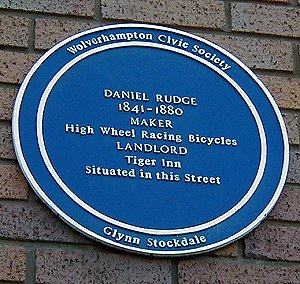 |
Commemorating:
Dan Rudge, bicycle manufacturer and landlord.
Sponsored by:
Glynn Stockdale
Location:
On the Telecom Building in Church Street.

|
| Daniel Rudge was landlord of the Tiger's Head in
Church Street. He took part in the bicycle races that were held
in the grounds of the Molineux Hotel and won the very first race
to be held there. He was very successful and built his own
bicycles. In 1870 he started manufacturing racing machines, the
first of which was a high wheeler. He made many
improvements to his bicycles and they soon became the best
racing machines that were available at the time. In 1878 he was
awarded a gold medal for his exhibit at the London Cycle Show.
He continued to run the Tiger's Head until his death in 1880.
His widow continued with the cycle business for sometime, but
eventually sold out to George Woodcock, who moved the business
to Coventry. |
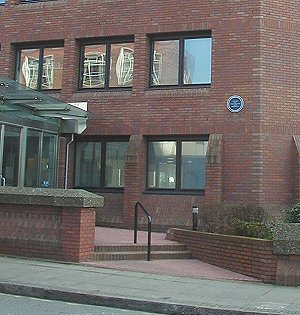 |
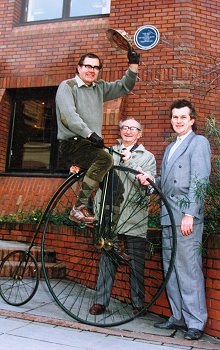 |
Glynn Stockdale on his Rudge cycle at the unveiling of the blue plaque.
Courtesy of Dick Rhodes. |
 |
Commemorating:
The Villiers Reform Club.
Sponsored by:
Larry McLean.
Location:
6 George Street. |
| Charles Pelham Villiers (1802-1898) was a member
of Parliament for sixty three years, and holds the record for
being the longest serving MP in Parliamentary history. From
1835-1885, he sat as MP for the single constituency of
Wolverhampton and then from 1885 until his death in 1898 as MP
for Wolverhampton South (Bilston).
|
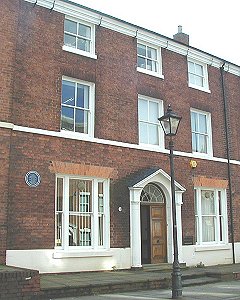 |
|